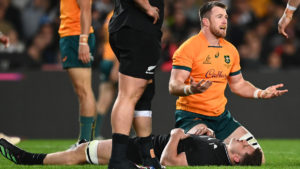Dr Boreham’s Crucible: It’s no pain, no gain for this MVP, but can it finally become the GOAT?

Tim Boreham is one of Australia's best-known small-cap share analysts and business journalists.
No company wants sub-optimal returns on their product – and pain-management house Medical Developments International (ASX:MVP) is no exception.
For some years, management has believed that customers undervalued the worth of its flagship product, the first-line inhaled analgesic device Penthrox.
Colloquially known as the ‘green whistle’, Penthrox’s methoxyflurane is administered to grimacing injured sportspeople as they limp from the field.
Of course, jacking up prices is notoriously difficult. But Medical Developments had a lucky break after Australia’s Pharmaceutical Benefits Scheme (PBS) approved a 25% increase, effective from August 1 this year.
There’s nothing like a government body – the one that shells out reimbursement – ticking off on such a hefty increase.
CEO Brent MacGregor says the PBS approval will help the company to edge up pricing elsewhere, with improved returns in the UK and Ireland already apparent.
“Where appropriate, we intend to adopt this increase in other parts of the market,” he says.
A trifecta of better pricing, lower costs and sharper strategy helped the hitherto struggling company to report what management dubs a greatly improved result for the year to June 30, 2024 – but investors need to peer beyond the official $41 million loss (see below).
MacGregor describes the results as encouraging “with strongly improved margins, earnings and cash flow”.
But the company is not pain-free yet. Its long-planned US approval quest has been put on hold, as has a proposed trial in China and development of a self-administered extension product called Selfie.
The story to date
Medical Developments is all about re-inventing methoxyflurane – first used here in 1975.
Medical Developments holds worldwide rights to the 46-year-old painkiller and is its only manufacturer, with the Penthrox units used for inhaling the methoxyflurane made at two Melbourne facilities.
Last year the company sold 764,000 Penthrox units, mainly in Australia (327,000) and Europe (282,000).
Methoxyflurane is also used as a veterinary drug, having been approved a decade ago in the US under the brand name Anafane.
The company also produces respiratory devices such as asthma spacers and masks and portable nebulisers, sold under the Breath-a-tech banner.
Medical Development was founded by prominent anesthetist Dr David Komesaroff, waaay back in 1972.
Penthrox was (and is) pitched as a rival product to nitrous oxide (laughing gas), morphine, fentanyl (a powerful opioid) and ketamine (better known as a party drug and horse tranquilliser).
Steered by then chair and major shareholder David Williams, Medical Developments listed on the ASX in December 2003, after raising $8.7 million at 25 cents apiece.
Since then, Medical Developments has expanded into more than 40 countries – the US being a notable exception for Penthrox, see below – with more than seven million patients administered methoxyflurane safely and effectively.
In March 2022 CEO John Sharman resigned after a 10-year stint and shortly after bobbed up to head ASX-listed device maker Universal Biosensors.
MacGregor assumed command in November 2020.
MacGregor was the head of commercial operations at Seqirus (CSL’s old ’flu division) and formerly headed Novartis’s influenza arm.
The founder of advisory firm Kidder Williams and chair of Polynovo and Inoviq, Williams resigned from the board in April 2023 “to pursue other personal and business interests”.
Financials and performance
In August, Medical Developments reported a net loss of $41 million, compared with a $5.6 million loss previously. The company also made an underlying loss of $8.2 million, an improvement on the previous $15.1 million deficit.
In truth, the key financial data was outlined in July, when the company embarked on a placement and rights issue that raised $10 million at 38 cents apiece (the retail leg raised $1.5 million, with a $1.6 million shortfall taken up by underwriters).
The bottom-line loss was attributable mainly to non-cash asset impairments, a one-off non-cash share payment expense relating to MacGregor’s remuneration and a de-recognition of tax losses.
Management focused on metrics such as the 2.7% revenue boost to $33.2 million, a five basis-point improvement in gross margins (to 74%) and a $10 million improvement in free cash flow (to a negative $14 million).
Pain management (Penthrox) revenue grew 4% to $21.3 million, with strong growth in Australia and Europe offset by lower revenues elsewhere (mainly as a result of higher prior-year inventory stocking in Canada, ahead of a re-launch).
The Nordic regions were especially strong, while French sales held up despite limited commercial activity there.
Driven by US sales, respiratory revenue improved 1.7% to $11.9 million, despite soft seasonal conditions in Australia, and European destocking.
Corporate costs fell by $5 million, with a further $3-$4 million reduction expected in the current financial year.
MacGregor says the company targets positive operating cash flow by the end of 2025. He expects underlying earnings to “strongly improve” this year, driven by higher Penthrox prices and operating efficiencies.
Over the past 12 months Medical Developments shares have traded between $1.02 (Jan 4) and 38 cents (May 23).
The stock peaked at $10.50 in February 2020, just before the sharp-but-short share market meltdown as Covid crept across the land.
Australian EDs ease the pain
MacGregor notes a 30% volume growth from emergency departments (EDs) – albeit from a small base – as more hospitals list Penthrox as suitable for use.
An additional 44 hospitals have added Penthrox to their treatment protocols, while the number of hospitals purchasing the device grew by 68, to 244.
These include key Melbourne and Sydney emergency departments, with Penthrox listed for use across South Australian emergency departments.
But MacGregor says emergency department take-up has been “slower than expected” and more time and effort will be needed.
“In short, ED physicians will need to learn more [about the product] to shift their behaviour and influencing this will be a key effort for us.”
To support take-up, the company has moved from a field-based sales approach to a stronger “medical engagement” in hospitals.
“We have concrete evidence that once use of Penthrox is established … it embeds a standard-of-care,” he says.
“Our progress here will be leveraged to support our partner efforts in international markets, not just those we are in now but those we will seek to enter.”
MacGregor also reports increased interest in obstetrics and gynaecology, which is not surprising given child birth involves an awful lot of screaming – mostly from the dad but some from the mum and the bub as well.
Swooping on the kids’ pain market
In 2019, the company launched a UK-based study called Magpie, which assessed the use of Penthrox for children and adolescents with acute trauma-related pain.
The 110-patient placebo-controlled study aimed to support the use of Penthrox for kids aged as young as six, compared with the current cut-off of 18 years.
The company warbled that the study met its aim of showing that the device was just as safe and efficacious for kids as adults; and submitted an approval application to European authorities on August 14 with an answer expected by August 2025.
MacGregor says the Magpie results should increase the use of Penthrox by UK ambulance trusts, many of which are reluctant to adopt it while use is restricted to adults.
Publication of the results in a peer-reviewed journal is “close at hand”.
European tune-up
In Europe, the company’s biggest non-Australian market, the company has adopted a “capital light” operating model and scaled down promotional activity.
But management is happy with the performance of Gaelen, its UK and Irish distributor. In July, the company expanded the eight-year-old-arrangement.
The company is in discussions with potential distributors in France and Switzerland.
Meanwhile, China is not Europe but we should mention that the company discontinued Penthrox trials in the Middle Kingdom in January 2023.
US misses …
In April 2024, the company said its long quest for US regulatory approval for Penthrox had been “paused”, in favor of focusing on its operations elsewhere.
For years, the company has sought US approval, but has been burdened by history: methoxyflurane was used as an anaesthetic in the US, but not an especially good one and the agency withdrew approval for its use as a numbing agent. The company says the anaesthetic had 20 times the dose of the Penthrox’s device, with a different patient population.
This left Medical Developments the last man standing – Steven Bradbury-like – as the only methoxyflurane developer by the end of the 1980s.
In July 2018, the FDA slapped a ‘clinical hold’ on the proposed trial program on undisclosed concerns, but lifted it in March 2022. The company’s investigational new drug application – a precursor for carrying out a supportive trial – remains open and last October the company had a positive meeting with the regulator to hone the costs and timelines.
MacGregor says there’s still an “attractive investment opportunity” for Penthrox in the US.
The decision to halt development of Selfie was related to the US pause, because the US is considered the most appropriate market for the device (given the greater prospect of reimbursement for Selfie’s higher cost of goods relative to Penthrox).
… and hits
While US Penthrox approval is on ice, the stars-and-stripes nation has proved highly receptive to its respiratory products, with revenues there increasing 37% last year.
These sales also have increased at a three-year compound annual growth of 30%.
MacGregor says there’s still a lot of upside in the US, given the spacers are still not stocked by the two largest chemists, Walgreens and CVS.
The company also is targeting hospital networks and group purchasing organisations.
Dr Boreham’s diagnosis
One would have thought that given the raging opioid usage problem in the US, the company would have a good case for gaining Penthrox approval there.
But as we know, the FDA can move in mysterious ways.
In the meantime, MacGregor expects the overall “positive momentum to continue in the current year”.
Five years ago, we pondered whether Medical Developments – ASX code MVP – could become the ASX-listed biotech sector’s GOAT.
(That was an incredibly witty reference to the sporting terms Most Valuable Player and Greatest of All Time.)
The financial results show that Medical Developments’ tune-up is starting to show reward. While GOAT status remains elusive, the company is playing well enough not to be benched, although investors sitting on steep losses may demand the company to lift its game further.
Medical Developments at a glance
ASX Code: MVP
Share price: 44 cents
Shares on issue: 112,658,324
Market cap: $49.0 million
CEO: Brent MacGregor
Board: Gordon Naylor (chair), Dr Russell Basser, Mary Sontrop, Christine Emmanuel-Donnelly, Leon Hoare, Richard Betts
Financials (year to June 30 2024): revenue $33.15 million (up 2.5%), underlying net loss $8.2 million ($15.1 million loss previously), net reported loss $41 million ($5.6 million loss previously), cash of $9.7 million ($18.9 million in mid-August, after $10 million capital raising)
Major identifiable shareholders: David Williams 11.6%, Regal Funds 10% FIL Ltd (Fidelity) 4.5%
Disclosure: Dr Boreham is not a qualified medical practitioner, does not possess a doctorate of any sort and never troubles the scorers in backyard footy.
This column first appeared in Biotech Daily.
Related Topics

UNLOCK INSIGHTS
Discover the untold stories of emerging ASX stocks.
Daily news and expert analysis, it's free to subscribe.
By proceeding, you confirm you understand that we handle personal information in accordance with our Privacy Policy.








